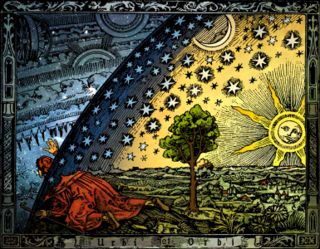
Astrology (from Greek: ?????? (astron), “star”, and ????? (logos), “theory”, “study”: lit. study of the stars) is a group of systems, traditions, and beliefs in which knowledge of the relative positions of celestial bodies and related details is held to be useful in understanding, interpreting, and organizing information about personality, human affairs, and other terrestrial matters. A practitioner of astrology is called an astrologer, or, rarely, an astrologist. Numerous traditions and applications employing astrological concepts have arisen since its earliest recorded beginnings in the 3rd millennium BC. It has played a role in the shaping of culture, early astronomy, and other disciplines throughout history.
Astrology and Astronomy were often indistinguishable before the modern era, with the desire for predictive and divinatory knowledge one of the primary motivating factors for astronomical observation. Astronomy began to diverge from astrology after a period of gradual separation from the Renaissance up until the 18th century. Eventually, astronomy distinguished itself as the scientific study of astronomical objects and phenomena without regard to the astrological speculation of these phenomena.
Astrology is often defined as the study of the influences of the cosmos on life on earth. Modern astrologers define astrology as a symbolic language, a science, an art form, and a form of divination. Despite differences of definitions, a common assumption of astrology is the use of celestial placements in order to explain past and present events and predict the future.
The core beliefs of astrology were prevalent in most of the ancient world and are epitomized in the Hermetic maxim “as above, so below”. Tycho Brahe used a similar phrase to summarize his studies in astrology: suspiciendo despicio, “by looking up I see downward”.
Current traditions
The main traditions used by modern astrologers are:
* Vedic astrology
* Western astrology
* Chinese astrology
Vedic and Western astrology share a common ancestry as horoscopic systems of astrology, in that both traditions focus on the casting of an astrological chart or horoscope, a representation of celestial entities, for an event based on the position of the Sun, Moon, and planets at the moment of the event. However, Vedic astrology uses the sidereal zodiac, linking the signs of the zodiac to their original constellations, while Western astrology uses the tropical zodiac. Because of the precession of the equinoxes, over the centuries the twelve zodiacal signs in Western astrology no longer correspond to the same part of the sky as their original constellations. In effect, in Western astrology the link between sign and constellation has been broken, whereas in Vedic astrology it remains of paramount importance. Other differences between the two traditions include the use of 27 (or 28) nakshatras or lunar mansions, which have been used in India since Vedic times, and the system of planetary periods known as dashas.
In Chinese astrology a quite different tradition has evolved. By contrast to Western and Indian astrology, the twelve signs of the zodiac do not divide the sky, but rather the celestial equator. The Chinese evolved a system where each sign corresponds to one of twelve ‘double-hours’ that govern the day, and to one of the twelve months. Each sign of the zodiac governs a different year, and combines with a system based on the five elements of Chinese cosmology to give a 60 (12 x 5) year cycle. The term Chinese astrology is used here for convenience, but it must be recognised that versions of the same tradition exist in Japan, Vietnam, Thailand and other Asian countries.
In modern times, these traditions have come into greater contact with each other, notably with Indian and Chinese astrology having spread to the West, while awareness of Western astrology is still fairly limited in Asia. (Wikipedia)
